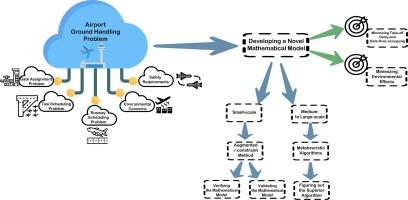可持续高效机场物流管理的新型双目标模型:哥本哈根机场案例研究
IF 6.7
1区 工程技术
Q1 COMPUTER SCIENCE, INTERDISCIPLINARY APPLICATIONS
引用次数: 0
摘要
由于航空运输量的不断增长和机场资源的稀缺,航空规划人员越来越重视机场资源管理的效率。优化地面设施的分配和调度对减少地面拥堵、航班延误和乘客不满起着重要作用。为防止飞机在停机坪、滑行网络和跑道上发生碰撞,交通管制人员应严格遵守安全注意事项。尽量缩短滑行时间是机场物流管理的另一个重要事项,有助于减轻环境问题(如燃料消耗、轮胎磨损和噪音污染)。本研究开发了一个双目标混合整数线性规划模型,用于优化地面资源调度问题,同时考虑到登机口分配、滑行规划和跑道调度等难题。该模型的开发还考虑到了安全性和可持续性。通过几个基于哥本哈根机场的实例,使用增强ε约束方法对所提模型进行了验证。由于同时调度多种资源是一个 NP 难问题,因此采用了两种多目标元启发式算法来处理大型问题。然后从覆盖率和收敛率方面比较了算法的性能。此外,还对结果进行了详细讨论,为机场当局提供了管理启示。本文章由计算机程序翻译,如有差异,请以英文原文为准。

A novel bi-objective model for sustainable and efficient airport logistics management: A case study on Copenhagen airport
Due to the growing volume of air transportation and the scarcity of airport resources, aviation planners are paying more attention to the efficiency of airport resource management. Optimizing the assignment and scheduling of ground facilities plays an important role in reducing ground congestion, flight delays, and passenger dissatisfaction. To prevent any collisions among aircraft on the apron, taxi network, and runways, safety considerations should be strictly followed by traffic controllers. Minimizing taxi time is another matter of importance in airport logistics management that helps mitigate environmental concerns (e.g., fuel consumption, tire abrasion, and noise pollution). In this study, a bi-objective mixed-integer linear programming model is developed to optimize the ground resource scheduling problem, taking into account the challenges of gate assignment, taxi planning, and runway scheduling. The model is developed in a way that includes safety and sustainability considerations. The validation of the proposed model is investigated through several examples based on Copenhagen airport using the augmented -constraint method. Since the simultaneous scheduling of multiple resources is an NP-hard problem, two multi-objective metaheuristic algorithms are employed to deal with the large-scale problems. The performance of the algorithms is then compared in terms of coverage and convergence rates. Additionally, the results are discussed in detail to provide managerial implications for airport authorities.
求助全文
通过发布文献求助,成功后即可免费获取论文全文。
去求助
来源期刊

Computers & Industrial Engineering
工程技术-工程:工业
CiteScore
12.70
自引率
12.70%
发文量
794
审稿时长
10.6 months
期刊介绍:
Computers & Industrial Engineering (CAIE) is dedicated to researchers, educators, and practitioners in industrial engineering and related fields. Pioneering the integration of computers in research, education, and practice, industrial engineering has evolved to make computers and electronic communication integral to its domain. CAIE publishes original contributions focusing on the development of novel computerized methodologies to address industrial engineering problems. It also highlights the applications of these methodologies to issues within the broader industrial engineering and associated communities. The journal actively encourages submissions that push the boundaries of fundamental theories and concepts in industrial engineering techniques.
 求助内容:
求助内容: 应助结果提醒方式:
应助结果提醒方式:


